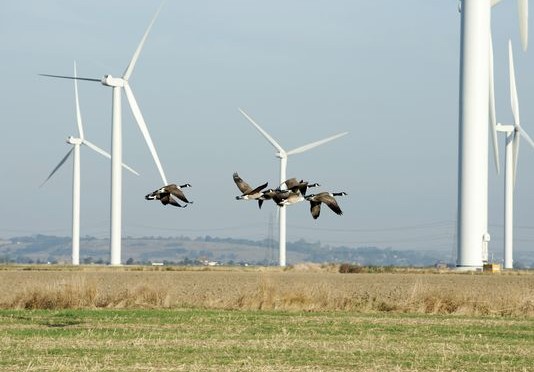“When you look at a wind turbine, you can find the bird carcasses and count them. With a coal-fired power plant, you can’t count the carcasses, but it’s going to kill a lot more birds.” — The Audubon Society
Wind energy producers are working diligently to prevent the deaths of birds and bats around their sites. The threats are real, but it is important to put the problem into perspective.
As John Anderson of the American Wind Energy Association explains: “Saying wind power can only be green if there are no impacts is like saying medicine can only be effective if it has no side effects. At some point, we need to put the benefits and risks into context.”
According to the U.S. Fish & Wildlife Service, the estimated annual bird mortality by cause is the highest with domestic cats (2.4 billion), building glass (599 million), auto collisions (215 million), power line collisions (25.5 million), communication towers (6.6 million), oil pits (750,000) and wind turbines (234,000). Bat mortality may be as high as an average of 888,000 per year.
Wind energy producers are doing much more mitigation than in any other of these problem areas. It begins with locating sites that are out of migratory routes and areas that do not produce food that birds prefer.
Tilling the soil around the sites also has preventive value, because the lack of cover means that there were far fewer prey species for raptors. A 2019 study revealed that, over a two-year period, there was a 75 to 100 percent decline in collisions using this simple technique.
Early lattice-style rotor blades, which encouraged nesting and roosting, have been phased out. The blades are now solid and much larger, and that means, according to one expert, “they don’t have to spin as fast to generate power. Slower-moving blades mean fewer bird collisions.”
Detection by radar and GPS has also proved to be effective. Most California’s condors are carrying GPS transmitters, and if the receivers pick up a signal near any wind farm, the operators will shut down the turbines. As a result, no condors have died because of wind farms.
One of the most promising technologies, especially with regard to mitigating raptor deaths, is IdentiFlight, which “blends artificial intelligence with high-precision optical technology to detect eagles and other protected avian species.” It can detect birds as far as 1 kilometer away, and it will stop the turbines if the birds come too close.
IdentiFlight data bases around the world now store 47 million images, and the AI program is getting increasingly more accurate. A study done in Wyoming showed 96 percent accuracy and only 6 percent false negatives, and eagle mortality was reduced by 82 percent. Another study found that this system was 5.62 times more accurate than birder identification.
New software has been designed to detect bat activity in the “rotor swept” area, and it automatically shuts down the affected turbines. Bats rarely fly in high winds, so threshold rotor speed in Pennsylvania was increased from 4 to 5.5 meters per second, and that reduced bat mortality by 93 percent percent. Turbine operators elsewhere in the U.S. and Europe are also finding this a successful strategy.
Scientists working with Bat Conservation International have developed “a bat deterrent system that jams bats’ echolocation capabilities with ultrasound.” Testing over two years reduced bat mortality by 54 percent. Much better results were found for Brazilian free-tailed bats and hoary bats, the latter suffering half the deaths from wind turbines.
Another less costly solution is to place 3D echolocation whistles, modeled on a bat’s larynx, directly on the rotor blades. These can be designed to correspond to the predominate bat species in the area. Passively powered, the whistles generate ultrasonic warning signals at a distance of 100 meters.
Changing the color of the rotor blades (purple is the best) has also reduced the number of insects around wind turbines and that has obviously reduced both bat and bird deaths. Painting one of the three blades black has proved to alert birds to rotor hazard. A Norwegian experiment showed that there was a 72 percent reduction in avian mortality using this simple solution.
As a show of confidence in mitigation efforts, the American Bird Conservancy, the Wisconsin Bird Initiative, Audubon Society have supported wind energy as preferable over fossil-fuel generators. An Audubon spokesperson states: “When you look at a wind turbine, you can find the bird carcasses and count them. With a coal-fired power plant, you can’t count the carcasses, but it’s going to kill a lot more birds.”
In New South Wales, over 30,000 flying foxes have died because of Australia’s extreme heat waves, so climate change will have much more devastating effects on the survival of bat populations than wind turbines. Bat migrations have been disrupted and scientists fear that they will be out of sync for their essential pollination duties. Bats must drink every day so extended droughts will affect their survival.
Insect populations are also steadily declining and that will obviously affect all insectivorous species. An October 2019 report from the National Audubon Society found that nearly two-thirds of bird species in North America are at risk of extinction from climate change.
Fungus based white-nose syndrome has killed an estimated 6 million bats in the U.S., and global warming has been suspected but not yet proved to be one of the conditions for its virulent spread.
Fossil fuels are the main contributor to climate change, and it is imperative that we replace carbon-based energy with wind turbines and solar panels. The future of the planet is in our hands.
Nick Gier of Moscow is a professor emeritus at the University of Idaho.

By Nick Gier


